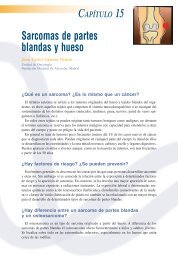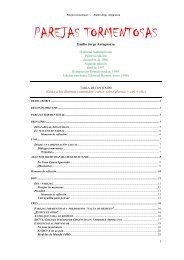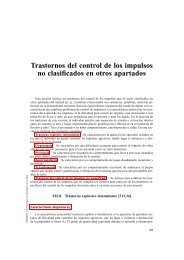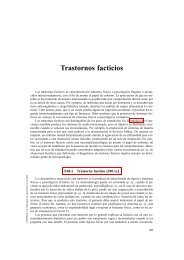Descarga
Descarga
Descarga
Create successful ePaper yourself
Turn your PDF publications into a flip-book with our unique Google optimized e-Paper software.
FUNDAP | ex - IAEPD 44 | PERSONA<br />
Dolores Mosquera, Anabel Gonzalez, & Onno van der Hart<br />
Borderline personality disorder,<br />
childhood trauma and structural<br />
dissociation of the personality<br />
INTRODUCTION<br />
Abstract<br />
Borderline personality disorder and dissociation are strongly<br />
Different factors have been proposed in the origin of bor-<br />
related. DSM-IV-TR criteria of BPD, for instance, include isolated<br />
dissociative symptoms (APA, 1994). Two thirds of BPD<br />
derline personality disorder (BPD). Some authors have<br />
may be diagnosed of a dissociative disorder (Korzekwa, Dell remarked on the importance of genetic personality traits<br />
and Pain, 2009). Both diagnoses have been related with high (Siever, Torgersen, et al, 2002) and their role as risk or pro-<br />
rates of childhood trauma. The close relationship between tective factors with regard to sensitivity to context (Steele &<br />
trauma, dissociation and borderline features can be unders- Siever, 2010). Others have related early attachment relationtood<br />
from the perspective of the theory of structural dissociaships and BPD symptomatology (Barone, 2003; Buchheim<br />
tion of the personality (Van der Hart, Nijenhuis & Steele,<br />
et al, 2007; Grover et al, 2007; Bakermans-Kranenburg &<br />
2006/2008) which transcends the traditional approach of<br />
describing "comorbidity". In this article we will review the Van IJzendoorn, 2009; Newman, Harris & Allen, 2010).<br />
empirical data which support the relation between early Some researches point to a higher prevalence of trauma, in<br />
traumatizing and attachment disruption situations, and both particular early, severe and chronic trauma among adult<br />
borderline and dissociative symptoms. Borderline personality borderline patients (Horesh et al 2008; Tyrka et al, 2009; Ball<br />
disorder will be explained in terms of structural dissociation & Links, 2009). High rates of dissociative symptoms have<br />
of the personality.<br />
been reported in the literature. Some authors consider these<br />
dissociative symptoms as symptoms of a personality disorder<br />
(Linehan, 1993, 2006), while others argue that some<br />
true dissociative disorders have been misdiagnosed as borderlines (Sar, Akyüz &<br />
Dogan, 2007; Putnam, 1997).<br />
Some authors (Zanarini, 2000; Zanarini, Yong, Frankenburg et al, 2002) found a<br />
high prevalence of traumatizing events. Overall severe early traumatization and<br />
attachment disturbances are frequent in the history of BPD patients, and TDSP can<br />
bring some light to the link between early experiences, and the adult symptoms, as<br />
we will describe in further sections.<br />
The study of isolated factors is important to understand the role of different aspects<br />
in the development of a disorder. But more comprehensive theories are needed to<br />
include individual factors in a global framework. The theory of structural dissociation<br />
of the personality (TSDP) offers a comprehensive theoretical explanation of how early<br />
experiences, including certain attachment styles and relational trauma, can generate<br />
a division of the personality. This division manifests in both borderline symptoms and<br />
those of dissociative disorders; from this perspective, they share a common origin.<br />
Thus, the term “structural dissociation” does not refer only to dissociative disorders,<br />
but involves the recognition that dissociation is the basic feature of traumatization and<br />
posttraumatic responses.<br />
This article will review the evidence regarding attachment disturbances, early trauma,<br />
dissociation and personality disorders. Theory of structural dissociation of the personality<br />
will be briefly described. Genetic factors, childhood attachment and early<br />
trauma will be described as confluent factors that influence the development of different<br />
borderline features in each individual case. Finally, a tentative description of the<br />
BPD clinical phenomena will be presented.<br />
EARLY TRAUMA, ATTACHMENT DISRUPTIONS, AND BORDERLINE<br />
PERSONALITY DISORDER<br />
Early Trauma and Borderline Personality Disorder<br />
As described with regard to Criterion A of posttraumatic stress disorder (APA,<br />
1994), the classic vision of trauma considers it from the perspective of a traumatizing












